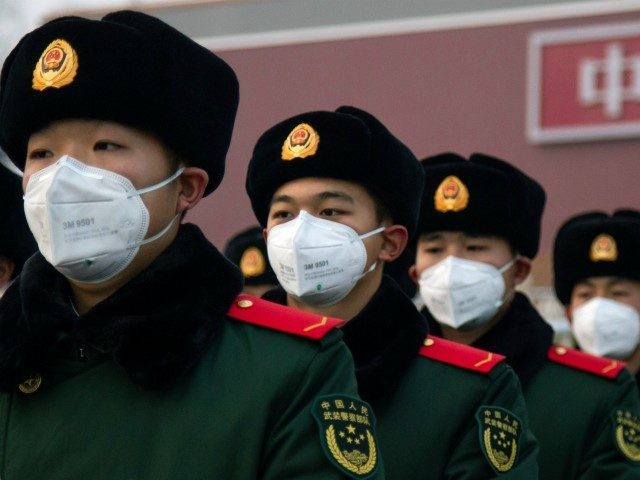Residents of the city of Wuhan, source of the worldwide coronavirus pandemic, expressed doubts about the Chinese government’s claim on Monday that absolutely no one is currently hospitalized with Chinese coronavirus.
People in Wuhan anonymously told foreign media they believed the claim of zero patients is a political stunt.
“Given the problem of information asymmetry we face, my gut feeling tells me that this zero-patient report is merely a political show after the authorities announced earlier that no treatment was necessary for recovered patients testing positive,” a Wuhanite told Voice of America News (VOA) on Monday, using the pseudonym “Yang” to avoid retaliation from the oppressive Chinese Communist Party (CCP).
“The harm from shutting down the factories has caused a worse impact on the ruling regime than that from the virus itself,” Yang said, explaining the CCP’s need to put on such a show.
VOA noted there have been conflicting statements from local and national health officials about how many confirmed coronavirus cases are still lingering in Wuhan. A national official said on Friday there were 47 of them, 30 asymptomatic but still testing positive for the disease. An official at Wuhan University said those patients would not be allowed to leave the hospital until they met the national standard of two consecutive negative tests. However, officials in the city of Wuhan and Hubei province claimed on Monday there are no coronavirus patients remaining in local hospitals.
Some of the Wuhan residents interviewed by VOA expressed fears that the government abandoned its discharge standards in a rush to push asymptomatic and recovering coronavirus patients onto the streets, so it could triumphantly claim none of them were still hospitalized.
“Am I the only one who feels there is a cover up?” one concerned citizen asked, while others reported sick relatives have been denied treatment or ejected from hospitals prematurely in the CCP’s rush to reach zero patients.
A citizen journalist named Zhang Zhan accused the Chinese government of faking negative tests so it could clear out the hospitals. Zhang reported personal contact with one patient who has supposedly tested negative nine times despite showing clear symptoms of coronavirus infection.
“This zero-patient claim must be fake,” Zhang concluded.
Disturbingly but unsurprisingly, human rights advocates told VOA that Wuhan residents have been harassed and intimidated out of filing formal complaints or lawsuits against the government. One advocate accused the Chinese government of using “gangster-like and cruel tactics to pressure them into giving up.”
According to the Chinese government, there is only one “high-risk” area left in the entire country for coronavirus infections: the Chaoyang district of Beijing, a fashionable area that includes most foreign embassies. The CCP claims that nearly all coronavirus infections still occurring in China have been brought in by the few foreigners allowed to cross the border under a strict travel ban – the same kind of travel ban the CCP and the World Health Organization (W.H.O.) fiercely criticized other countries for adopting, back when the coronavirus was largely confined to China.
Even in Chaoyang, the CCP claims only three coronavirus cases were reported in April. This was evidently enough to change the risk rating for the district from “low” to “high” and scuttle the travel plans of millions of residents. Many shops in the business district remain closed, and internal travel by foreigners and migrant workers is still sharply restricted.
The South China Morning Post on Monday quoted some statements from Chinese analysts that suggested the tough measures still effective in Chaoyang and a few other areas will be cited by the central government to explain disappointing economic statistics for April and May:
China’s continued pandemic prevention measures, coupled with still hesitant consumer demand, will inevitably lead to persistent limitations on the nation’s economic recovery, analysts said.
Ernai Cui, an economist at research firm Gavekal Dragonomics, said on Monday that China’s cautious approach to lifting restrictions “points to a weak second quarter for consumer services”, adding additional pressure to the economic recovery.
Mao Zhenhua, a researcher at the China Institute of Economics at Renmin University, said China’s preventive measures will inevitably be a drag on production, employment and exports.
The CCP’s talk of the Chaoyang district as the only “high-risk” area left in China is odd given that at least two large northern cities, Harbin and Suifenhe, were placed under coronavirus lockdown recently. Outside observers have noted that Harbin is beginning to resemble Wuhan at the height of the epidemic, accounting for three-quarters of China’s new coronavirus cases, most of them allegedly traced to a student who visited New York City and tested negative for the Wuhan virus four times upon her return to Harbin.
The central government is trying to downplay the extent of the infections in both cities, in part because the Russians are bristling at China’s insinuation that most of the coronavirus cases are coming across the Chinese-Russian border.

COMMENTS
Please let us know if you're having issues with commenting.